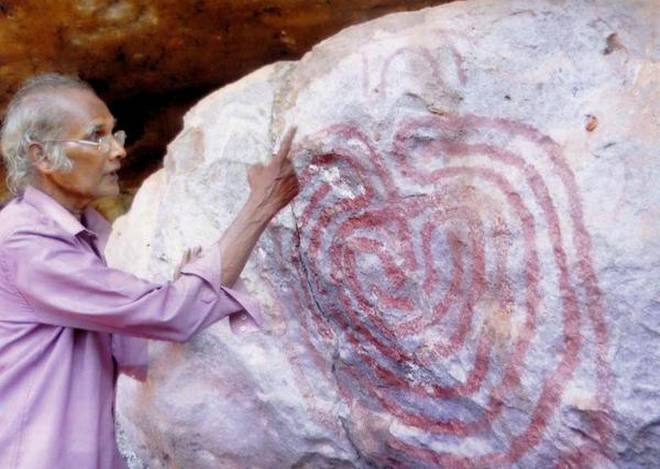
It throws light on ancient cult practices, says freelance archaeologist
A prehistoric painting of a mystic labyrinth has been discovered at a cave on top of a hill near Kolimeru village near Tuni in East Godavari district. The labyrinth, dating back to the Neolithic period, consists of seven circles in red ochre on white pigment painted on a rectangular rock in front of the cave facing the Sun.
“The discovery of the labyrinth throws light not only on the ancient religious practices of prehistoric civilisations, but also on their knowledge about astronomical signs. Ancient civilisations had worshipped Sun and were able to predict seasons and even natural calamities,’’ freelance archaeologist and former deputy director, Sports Authority of Andhra Pradesh, Kadiyala Venkateswara Rao told The Hindu on Friday.
Mr. Rao had earlier unearthed a unique Menhir at Karempudi in Guntur district that threw light on the existence of prehistoric civilisations in Guntur district.
The word labyrinth is an ancient Greek word with Minoan cultural influence and means extremely complicated and therefore difficult to understand.
The hills, known locally as ‘Bangaruloya,’ and the rock shelter ‘Pandavulavari Gani,’ have mystic folklore. Locals believe that Pandavas lived in this rock shelter during “aranyavasa,’’ and also thought mystic drawings could indicate that huge gold and precious things were hidden in the caves.
Line drawings
Mr. Rao, now aged 75 years, located the rock shelter after an arduous trek. The natural rock found at the entrance of the shelter has sacred Neolithic labyrinth motifs painted in red ochre on a white pigment. He also found line drawings of a bull and a deer on either side of the labryinth, though the colour has faded away. It is believed that the rock shelter might be a worshipping place of Neolithic hunter-gatherers.
“Ancient literature has thrown light on the ways in which priests studied the equinoxes, solstices and movements of Sun and Moon hoping to gain mastery over the elements. Cult priests might have also performed rituals and other ancestral worshipping practices in front of the labyrinth symbol,’’ Mr. Rao added.
Mr. Rao also discovered a prehistoric cup mark which are also found on other prehistoric sites such as dolmen and menhirs, sacred ritual symbols.
It is interesting to note that similar labyrinths have been found in Europe and other countries and are common in aboriginal art and usually associated with creative energy. In India, labyrinths have been found at Halibedu in Hoyasleshwara Swamy Temple in Karnataka, and in Goa and Rajastan, where they are worshipped as Manas Chakra, a religious emblem.
source: http://www.thehindu.com / The Hindu / Home> News> Cities> Vijayawada / by P. Samuel Jonathan / Guntur – October 21st, 2017